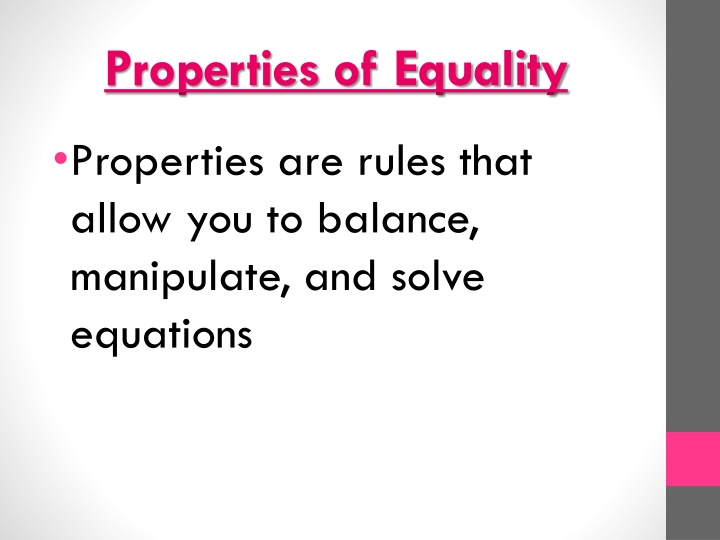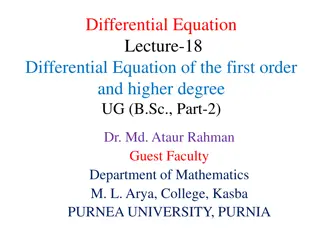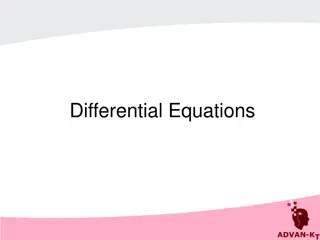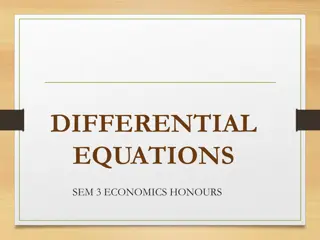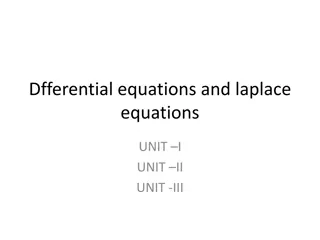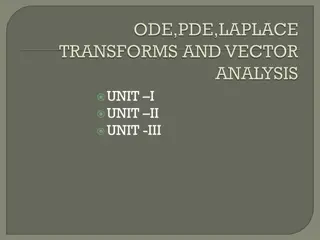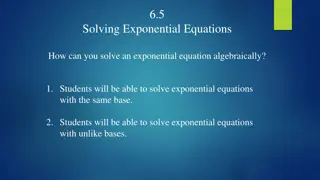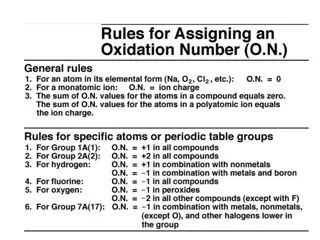Properties of Equality: Rules for Balancing Equations
The Properties of Equality that enable you to manipulate and solve equations effectively. Understand concepts like Addition, Subtraction, Multiplication, Division, Symmetric, Transitive, and Substitution Properties through clear examples. Additionally, learn about the Commutative Property in mathematical equations.
Download Presentation

Please find below an Image/Link to download the presentation.
The content on the website is provided AS IS for your information and personal use only. It may not be sold, licensed, or shared on other websites without obtaining consent from the author.If you encounter any issues during the download, it is possible that the publisher has removed the file from their server.
You are allowed to download the files provided on this website for personal or commercial use, subject to the condition that they are used lawfully. All files are the property of their respective owners.
The content on the website is provided AS IS for your information and personal use only. It may not be sold, licensed, or shared on other websites without obtaining consent from the author.
E N D
Presentation Transcript
Properties of Equality Properties are rules that allow you to balance, manipulate, and solve equations
Addition Property of Equality Adding the same number to both sides of an equation does not change the equality of the equation. If a = b, then a + c = b + c. Ex: x=y, so x+2=y+2
Subtraction Property of Equality Subtracting the same number to both sides of an equation does not change the equality of the equation. If a = b, then a c = b c. Ex: x = y, so x 4 = y 4
Multiplication Property of Equality Multiplying both sides of the equation by the same number, other than 0, does not change the equality of the equation. If a = b, then ac = bc. Ex: x = y, so 3x = 3y
Division Property of Equality Dividing both sides of the equation by the same number, other than 0, does not change the equality of the equation. If a = b, then a/c = b/c. Ex: x = y, so x/7 = y/7
Symmetric Property of Equality If numbers are equal, they will still be equal if the order is changed. If a = b, then b = a. Ex: x = 4, then 4 = x
Transitive Property of Equality If numbers are equal to the same number, then they are equal to each other. If a = b and b = c, then a = c. Ex: If x = 8 and y = 8, then x = y
Substitution Property of Equality If numbers are equal, then substituting one in for the another does not change the equality of the equation. If a = b, then b may be substituted for a in any expression containing a. Ex: x = 5, then y = x + 6 is the same as y = 5 + 6.
Other Properties
Commutative Property Changing the order of addition or multiplication does not matter. Commutative comes from commute or move around , so the Commutative Property is the one that refers to moving stuff around.
Commutative Property Addition: a + b = b + a Ex: 1 + 9 = 9 + 1
Commutative Property Multiplication: a b = b a Ex: 8 6 = 6 8
Associative Property The change in grouping of three or more terms/factors does not change their sum or product. Associative comes from associate or group , so the Associative Property is the one that refers to grouping.
Associative Property Addition: a + (b + c) = (a + b) + c Ex: 1 + (7 + 9) = (1 + 7) + 9
Associative Property Multiplication: a (b c) = (a b) c Ex: 8 (3 6) = (8 3) 6
Distributive Property a (b + c) = a b + a c Ex: 5 (x + 6) = 5 x + 5 6
Multiplicative Identity Property The product of any number and one is always the original number. a 1 = a Ex: 2 1 = 2
Additive Inverse Property The sum of a number and its inverse (or opposite) is equal to zero. a + (-a) = 0 Ex: 2 + (-2) = 0
Multiplicative Inverse Property The product of any number and its reciprocal is equal to 1. Ex: 4 5 =1 5 4 a b b a =1
Exponential Property of Equality Ex: b c a =a , then b=c x 4 2 =2 , then x =4
Homework Worksheet
